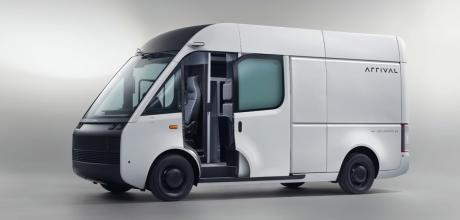21st century Transit - Arrival reveals electric panel van plus modular battery system
UK start-up Arrival is cleaning up with its 215-mile electric van and revolutionising taxis with Uber, says Jake Groves.
21st century Transit
Need a ride home after a night out? Or have you ordered something on one-day delivery? Chances are that, in the near future, the vehicle transporting you or your new dog onesie could be from UK start-up Arrival.
The Banbury-based operation is designing and engineering the future of all-electric commercial vehicles and buses, and the world is taking notice. It was named the number one startup to work for in the UK in 2020 by LinkedIn, orders for the van are flooding in from the likes of UPS and Royal Mail, and First Group – one of the biggest bus operators in the UK – is in talks with Arrival, too. Hyundai Motor Group has invested €100m (£85m) in Arrival to gain access to its EV engineering. ‘It’s the culmination of six years of hard work, and the team feels incredibly proud,’ says Tom Elvidge, Arrival’s senior vice-president of vehicle programmes.
Its van, Arrival’s first major project, is available in a range of shapes and sizes, with battery capacities ranging from 44 to 133kWh. Arrival estimates the van can do up to 215 miles on a single charge – plenty for a Royal Mail operative to perform a number of local delivery rounds, for example – and carry up to two tonnes. At the time of writing, Arrival is busy conducting trials of its production-spec vans, with the first ones hitting the road from 2022 onwards.
And then there’s the bus. The design is modular, with different lengths and battery ranges easily integrated into the matrix. Flat surfaces and sanitation stations (the bus was revealed during the first wave of the pandemic), along with wall-mounted panels with contactless payment functions, allow passengers to get on and off smoothly. Real-time updates via GPS tracking can be sent to your phone while you wait. How does a start-up like Arrival offer such flexibility in its products? It’s all down to the way they’re built. ‘We’ve designed our own components on a modular, grid-based system for simple assembly,’ says Elvidge. ‘Each component can be used across all of Arrival’s platforms, allowing manufacturing at scale and rapid development of new vehicle types.’
The start-up also isn’t one for centralising its production; instead, Arrival is setting up several ‘microfactories’. It buys up warehouse space near where demand is highest, to produce vehicles locally, transforming the space into small production hubs for whatever vehicle is required using something Arrival calls ‘cell-based assembly’ – a small footprint of square space in the microfactory designed to build one vehicle from the ground up. No rolling production lines or tight time deadlines, just the set of components put together by both robotic arms and humans. There are four in the world so far.
‘Cell-based assembly means we can create any vehicle from the portfolio, quickly being able to reconfigure the same plant to build different products,’ says Elvidge. ‘If demand for a particular product wanes, we can switch to a different one.
‘Microfactories make distribution and production cheaper, easier and more sustainable,’ he adds. ‘They’re designed to be long-lasting facilities and, combined with Arrival’s in-house hardware and software, will lower costs to such an extent that our products will be competitive on price with fossil-fuel equivalents, and have a much lower total cost of ownership.’
The next project? An electric car, designed purely for taxi use. Arrival is working with Uber, the ride-hailing giant, to design the ultimate EV for its drivers and passengers.
‘Ride hailing plays such a key role in creating accessible and efficient transport systems,’ says Elvidge. ‘An integrated transport ecosystem will create cleaner solutions for people living in cities.’
One cell ready for work inside a microfactory These will soon be very familiar sightsHyundai has invested £85m into Arrival to gain access to its EV engineering.
YOUR UBER IS AROUND THE CORNER
THE GREATER GOOD
Arrival knows that services like Uber are key to reducing congestion in cities, so designing a bespoke car for this market will help push along the transition. ‘It’s also addressing the global need to shift ride-hailing services over to electric to reduce emissions and improve air quality,’ adds Arrival’s Tom Elvidge.
SHARING’S CARING
The battery cells and platform use the same componentry as the van and bus, albeit scaled to size for a passenger car. This reduces costs, and modular construction allows Arrival to build its vehicles in the same production ‘cell’ with only minor tweaks to the overall toolkit. ‘The durability, comfort, functionality and purpose- built design of Arrival’s vehicles all lend themselves to ride hailing,’ says Elvidge.
FROM THE SOURCE
Arrival is calling on Uber drivers to give their feedback and demands on what the car should have, with surveys and driver focus groups from ‘key markets’ being set up at the time of writing.
Arrival has also reached out to mapping tech experts Here for navigation, with Elvidge pointing out that Here’s location data and flexibility make it a better fit than ubiquitous Google. A software system that can directly integrate with an Uber driver’s account and an expected maximum range of 186 miles is planned, too.
Elvidge adds: ‘Being able to drive and work a full day without needing to charge is a key requirement.’


